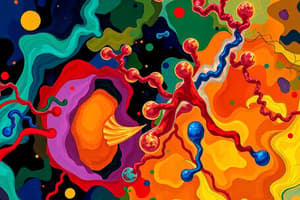Podcast
Questions and Answers
Which drug is most enthalpically favorable for binding to the receptor target?
Which drug is most enthalpically favorable for binding to the receptor target?
- Lopinavir
- Ritonavir (correct)
- Nelfinavir
- Indinavir
- Saquinavir
For which drug do you have to put the most heat into the system for binding, i.e., drug-receptor complex, to occur?
For which drug do you have to put the most heat into the system for binding, i.e., drug-receptor complex, to occur?
- Lopinavir
- Indinavir
- Ritonavir
- Saquinavir
- Nelfinavir (correct)
Amorphous drugs are __________ energetically stable than crystalline drugs.
Amorphous drugs are __________ energetically stable than crystalline drugs.
less
Amorphous drugs are __________ water soluble than crystalline drugs due to __________ entropy.
Amorphous drugs are __________ water soluble than crystalline drugs due to __________ entropy.
When albumin is added to a poorly water-soluble, hydrophobic drug in water, the entropy of the water molecules _________, breaking up the _________ intermolecular interactions between the water molecules.
When albumin is added to a poorly water-soluble, hydrophobic drug in water, the entropy of the water molecules _________, breaking up the _________ intermolecular interactions between the water molecules.
Which drug binding to the HIV protease is furthest away from equilibrium?
Which drug binding to the HIV protease is furthest away from equilibrium?
Which drug binding process is most spontaneous?
Which drug binding process is most spontaneous?
Which of these cocoa butter polymorphs would you predict to have a higher melting temperature?
Which of these cocoa butter polymorphs would you predict to have a higher melting temperature?
Which molecule would be predicted to have the highest boiling point?
Which molecule would be predicted to have the highest boiling point?
Given that there is no change of volume, which of the following First Law equations most accurately describes the change of internal energy associated with the degradation process?
Given that there is no change of volume, which of the following First Law equations most accurately describes the change of internal energy associated with the degradation process?
As you increase the temperature of the dissolution of glucose, which of the following is TRUE?
As you increase the temperature of the dissolution of glucose, which of the following is TRUE?
Flashcards are hidden until you start studying
Study Notes
Drug Binding and Enthalpy
- Nelfinavir has a ΔH of 3.1 kcal/mol, indicating relatively higher heat absorption for binding.
- Ritonavir is the most enthalpically favorable drug for receptor binding with a ΔH of -4.3 kcal/mol.
- Lopinavir has a negative ΔH of -3.8 kcal/mol, also indicating favorable binding.
- Indinavir and Saquinavir show intermediate values of ΔH at 1.8 and 1.2 kcal/mol, respectively.
Amorphous vs Crystalline Drugs
- Amorphous drugs exhibit less energetic stability compared to crystalline drugs.
- Amorphous drugs are more water-soluble due to higher entropy characteristics.
Drug-Albumin Interaction
- Adding albumin to a poorly water-soluble drug increases the entropy of water molecules.
- The intermolecular interactions between water molecules break down, facilitating drug solubilization.
- Albumin interacts with hydrophobic drugs through dispersion forces.
Free Energy and Spontaneity in Drug Binding
- Nelfinavir has a ΔG of -12.8 kcal/mol, while Indinavir is slightly less favorable at -12.4 kcal/mol.
- Ritonavir has a ΔG of -13.7 kcal/mol, indicating substantial binding strength.
- Darunavir (-15 kcal/mol) and Lopinavir (-15.1 kcal/mol) show the most spontaneous binding processes.
Cocoa Butter Polymorphs
- Form (I) cocoa butter polymorph is expected to have a higher melting temperature compared to Form (II).
Hydrocarbon Boiling Points
- Butane, with a molecular weight of 58.12 g/mol, is predicted to have the highest boiling point among methane (CH4) and propane (C3H8).
First Law of Thermodynamics
- In a closed volume chamber for pharmaceutical degradation, the internal energy change is described by the equation dE = dQ, indicating change in internal energy is equal to heat change.
Temperature Effects on Glucose Solubility
- For the endothermic dissolution of glucose, increasing temperature leads to increased solubility of glucose and an increase in the equilibrium constant.
Studying That Suits You
Use AI to generate personalized quizzes and flashcards to suit your learning preferences.




